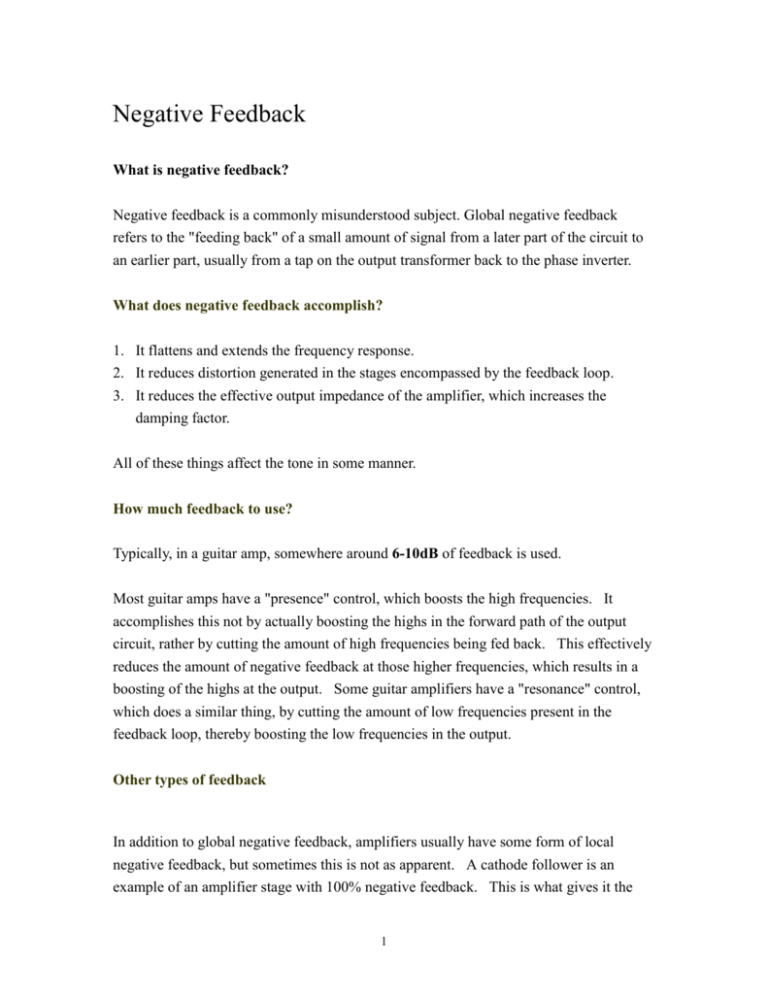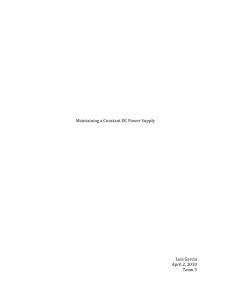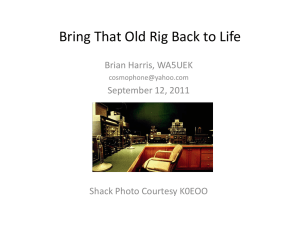Negative Feedback
advertisement

Negative Feedback What is negative feedback? Negative feedback is a commonly misunderstood subject. Global negative feedback refers to the "feeding back" of a small amount of signal from a later part of the circuit to an earlier part, usually from a tap on the output transformer back to the phase inverter. What does negative feedback accomplish? 1. It flattens and extends the frequency response. 2. It reduces distortion generated in the stages encompassed by the feedback loop. 3. It reduces the effective output impedance of the amplifier, which increases the damping factor. All of these things affect the tone in some manner. How much feedback to use? Typically, in a guitar amp, somewhere around 6-10dB of feedback is used. Most guitar amps have a "presence" control, which boosts the high frequencies. It accomplishes this not by actually boosting the highs in the forward path of the output circuit, rather by cutting the amount of high frequencies being fed back. This effectively reduces the amount of negative feedback at those higher frequencies, which results in a boosting of the highs at the output. Some guitar amplifiers have a "resonance" control, which does a similar thing, by cutting the amount of low frequencies present in the feedback loop, thereby boosting the low frequencies in the output. Other types of feedback In addition to global negative feedback, amplifiers usually have some form of local negative feedback, but sometimes this is not as apparent. A cathode follower is an example of an amplifier stage with 100% negative feedback. This is what gives it the 1 high input impedance and low output impedance, and the near-unity maximum gain. Some amplifiers will use a single-stage inverting amplifier circuit with local feedback from the plate to the grid via a large resistor and coupling cap. The gain of these inverting stages is set by the value of the feedback resistor in proportion to the value of the input resistor. Designing for Global Negative Feedback Closed loop gain of the amplifier: Acl ARi R f Ri R f R0 Ri A which simplifies to the following equation if the output resistance, Ro, is very small in comparison to the feedback resistance values, as is usually the case in guitar amplifiers: Acl A 1 A Where β is the feedback factor that Ri Ri R f 2 Example For the amplifier as shown above that it has a gain of 41 if it is opened loop, please find its closed loop gain and the corresponding gain reduction due to the negative feedback. 5k 1 5k 100k 21 Acl 41 1 1 41 21 13.89 The gain reduction due to the negative feedback in dB is 13.89 20 log 9.4 dB 41 3 Power Supply Design 1. Basic circuit diagram of full-wave rectifier with condenser input filter. A higher capacitance gives better regulation and a higher output voltage. But there is a maximum limit for the capacitance due to the peak current rating of the rectifier. 2. Basic circuit diagram of full-wave rectifier with choke input filter. 3. Rectifier valves and types of service Rectifier valves may be subdivided into the following groups: (1) High vacuum (a) High impedance (e.g. 5Y3-GT) (b) Medium impedance (e.g. 6X4, 5R4-GY) (c) Low impedance (e.g. 5V4-G, 35Z5-GT) (2) Mercury vapour – (e.g. 82, 83) The direct voltage output of mercury vapor rectifiers system is equal to 0.9 times the r.m.s. value of the input voltage minus the valve voltage drop. 4 Output voltage = (0.9 Erms – 15 ) volts In supplies feeding Class A output stages the choice will probably be a condenser input filter, but where Class AB1 and AB2 output stages are to be supplied, the regulation of the power supply becomes a significant feature and choke input filters with low impedance rectifiers must be used. Output Voltage Calculation Quad II Power Amplifier GZ32=5V4G Vin=310V I=147 mA Vout=340V 5 6 6X5 tube Using Voltage Regulator (VR) Tube A voltage regulator tube (VR tube) is an electronic component used as a shunt regulator to hold a voltage constant at a pre-determined level. Physically, these devices resemble vacuum tubes, but there are two main differences: Their glass envelopes are filled with a gas mixture, and They do not use a heater. Electrically, these devices resemble zener diodes, with the following major differences: 7 They rely on gas ionization, rather than avalanche breakdown The unregulated supply voltage must be 15-20% above the nominal output voltage to ensure that the discharge starts The output can be higher than nominal if the current through the tube is too low. The normal point of operation, which allows maximum variation in current, must be midway between the current limits of the tube. This median current is called Imean. and can be calculated by the use of the following equation: To calculate the value of series dropping resistance RS, we use the following equation: Exp. 8 Imean = (5+40)/2 =22.5 mA If the average load current is 100 mA, than Rs = (150 – 90)/(22.5+100)=0.49 (kohms) = 490 ohms VR Tubes Connected in Series In applications where a regulated voltage in excess of the maximum rating of one tube is required, two or more tubes may be placed in series. VR tubes could be operated in series for greater voltage ranges. They could not be operated in parallel: because of manufacturing variations, the current would not be shared equally among several tubes in parallel. 9 VR tubes were only available in certain voltages. Common models were: Octal-based tubes, 5-40 mA current: 0A3 — 75 volts 0B3 — 90 volts 0C3 — 105 volts (best regulation of these four) 0D3 — 150 volts Miniature tubes, 5-30 mA current: 0A2 —150 volts 0B2 — 105 volts 0C2 — 75 volts (best regulation of these three) Voltage reference 1.5-3.5 mA current: 5651 — 87 volts (the most popular voltage reference ever made) 5651-A– 85.5 volts Using Solid-State Diodes Bridge Full Wave Rectifier 10 Center-Tap Full Wave Rectifier Full Wave Rectifier Ripple Voltage IC voltage regulators – – – – – To most effectively reduce the ripple occurring after filtering we use and IC voltage regulator. A regulator has 3 terminals: input, output and reference (or adjust). In general, it is better to add capacitors after (and before) the regulator. A large capacitor between the input voltage and the input terminal further filters the signal. To improve transient response a smaller capacitor is added after the regulator. 11 – – The 78XX series are examples of positive output regulators. The 79XX series are examples of negative output regulators. Type Number Output Voltage 7805 5V 7806 6V 7808 8V 7809 9V 7812 12 V 7815 15V 7818 18V 7824 24 V LM317- 3 terminals adjustable voltage regulator 12 Maximum output current is 1 A, maximum voltage difference between in and out is 40 V. Preamplifier 13 5670/396A Preamplifier 14 6922 SRPP Preamplifier 15 Marantz 7 Preamplifier Mclntosh C-22 Preamplifier 16 17 Power Amplifier 1. Single Ended 2. Push Pull 1. Single Ended 18 2A3 Tube 19 Power output P ( Emax Emin )( I max I min ) 8 20 21 EL84 22 23 Push Pull Classes of Amplifiers. Class A, the plate current of both tubes is flowing uninterrupted over the entire cycle. In ideal class B the plate current is zero when there is no input signal. When the signal appears each tube conducts over half of the cycle. The two tubes work alternately so the whole cycle is amplified. Class B, the plate current of each tube flows for approximately 1/2 of the cycle and the two tubes work alternately. 24 Class AB1, somewhere between A and B but the grids are NEVER driven positive. Class AB2, somewhere between A and B but the grids ARE driven positive and there will be grid current. 25 26 Phase Splitter In a push-pull amp, you need a phase splitter to produce the two identical but in phase opposition signals to drive the power tubes. 27 Cathodyne (Concertina, or Split Load) Phase splitter The cathodyne is the most used phase splitter, probably because it's the simplest and yet quite effective. Pros: Very simple Performant when followed by a cathode follower before the power tubes Can be directly connected to the previous stage Cons: Low gain Not very linear because of the internal capacitances of the tube that are not identical between the grid and the plate or the grid and the cathode, but their values are usually so low that their effect is far away from the audio range Very sensitive to the load 28 For RA=RK=R A R R ( 2) ra Schmitt (Long Tail Pair) Phase Splitter 29 Gain calculation 1. For a single tube, Rk is equivalent to 620 x 2 = 1240 2. For a single tube, plate load is 100 k + 47 k x 2 = 194 k 3. Find a single tube gain if it is bypassed. A0= (mu x Rp)/(Rp+ra) = (70.4 x 194)/(194 + 44) = 57.38 4. Since it is unbypassed, the gain is 30 Aunbypassed = A0 / (1 + β x A0) = 57.38 41.98 1.24 1 57.38 194 5. The voltage excursion is divided by the real plate load and the 47 kΩ, so the final gain is A 100 41.98 21.64 100 47 2 Voltage Divider Phase Splitter 31 Is Point-to-Point Better Than PCB? Which is better, point-to-point (PTP), or printed circuit board (PCB)? You will find manufacturers arguing both sides, some quoting outlandish claims to support their argument, others claiming PTP is much better, then, when they start using PC boards, they claim PCB is better. What is the truth? 32 33 34







